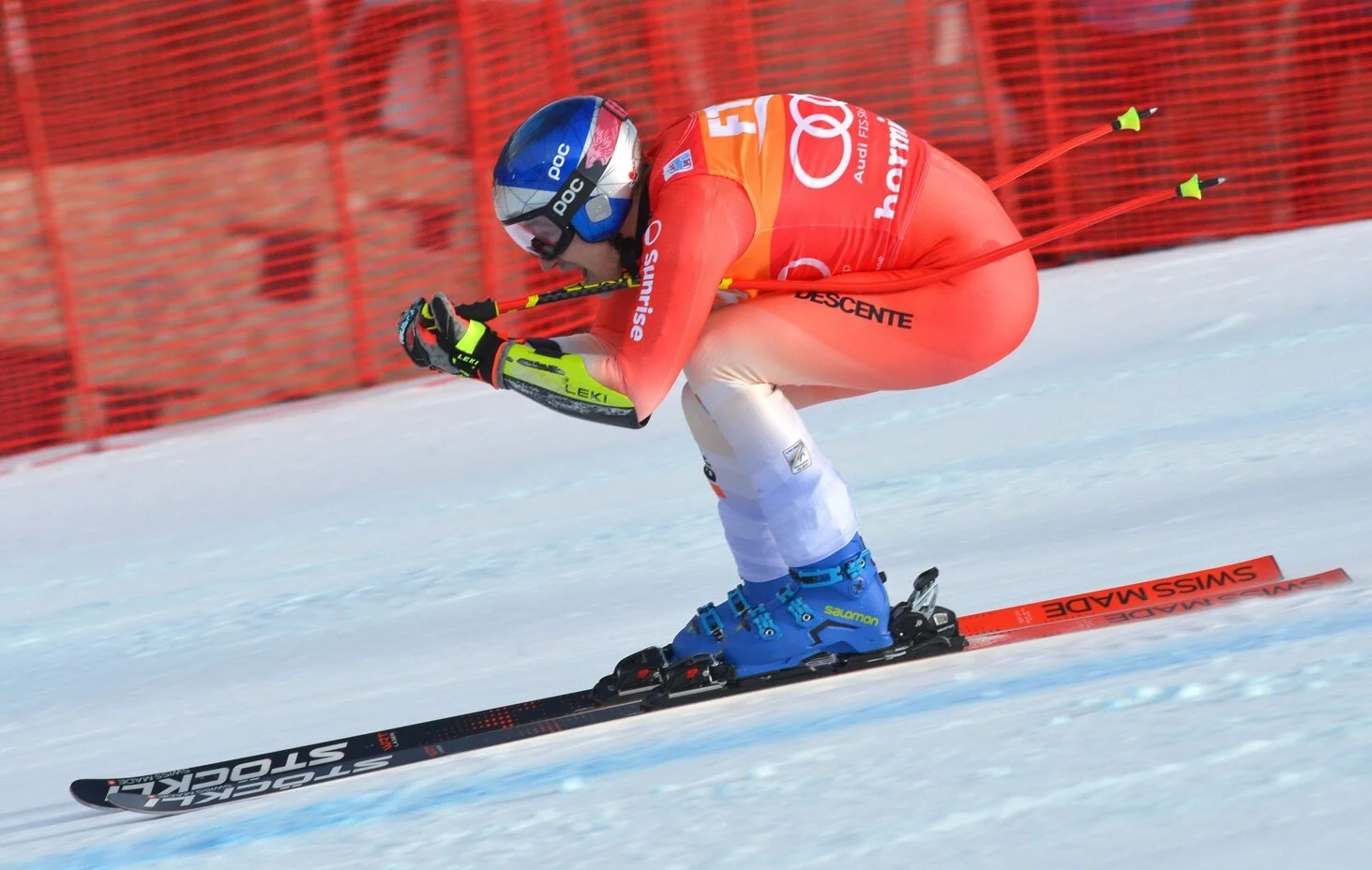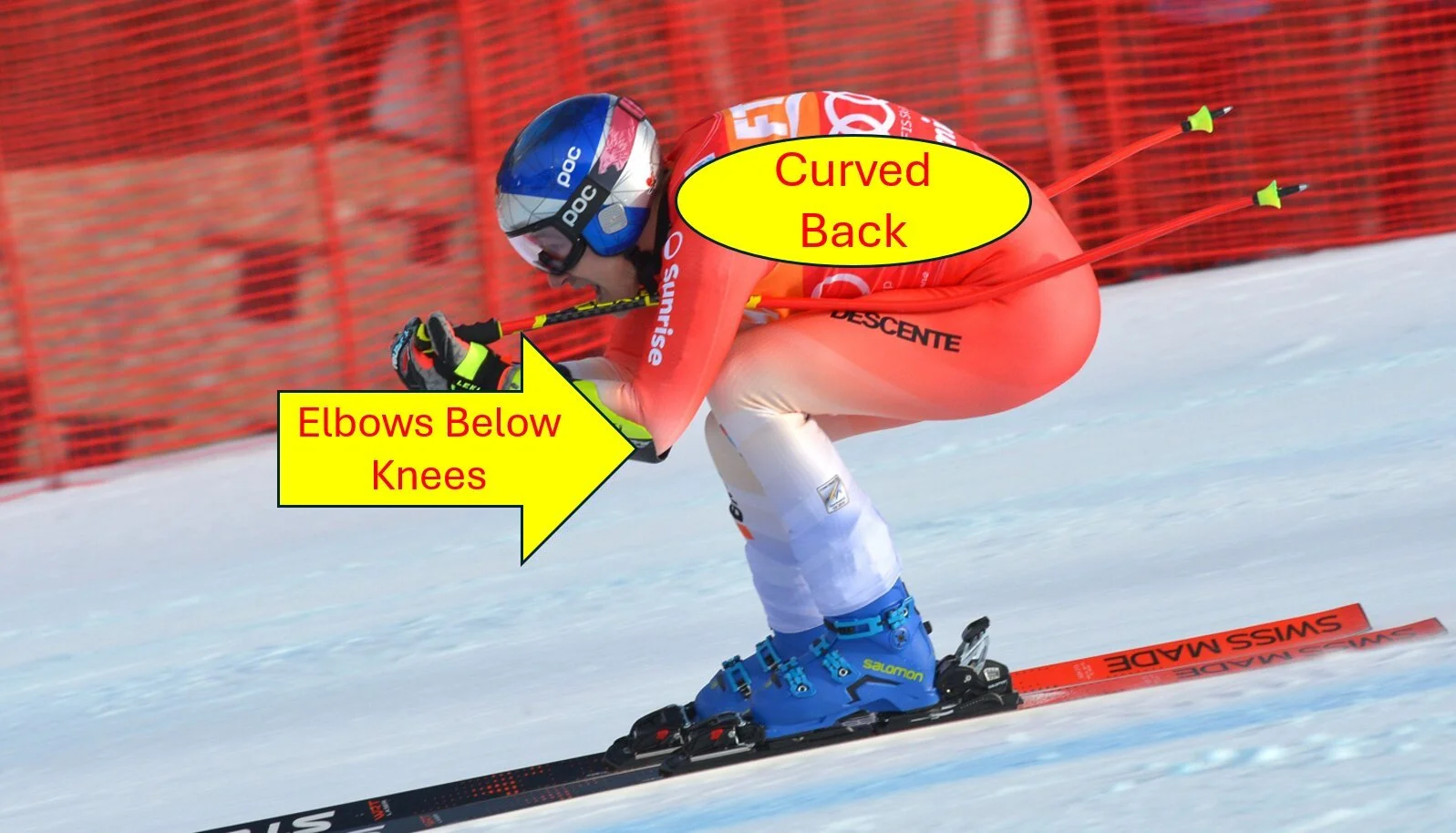Speed
M. Odermatt/Image by L.M.P Group/Alamy
Overview
Increase speed on the straighter sections of a racecourse using these strategies: use the High and Low Tuck stances to be more aerodynamic, glide on your ski bases and minimize edge angle.
High Tuck Stance
Where there is less offset between gates, but you still need to change direction, a High Tuck stance will help you gain speed and make clean, carved turns. Here’s how:
Flex both ankles forward, keep your back mostly flat and tip forward hinging at the waist until your elbows are above or in front your knees.
Push your hands forward in front of the face so you can just see over your gloves.
This position allows the legs, knees, and ankles to flex and absorb changes of terrain
IShiffrin/LMP Group/Alamy/Graphics by ARM
Deb Armstrong reviews when and how to tuck in her video.
Video by Ski Strong
Changing Direction
Here’s how to make clean, carved turns with a High Tuck stance.
Use your ankles and legs to roll your skis onto their edges.
Work on minimizing edge angle because the more the skis glide on their bases, the faster they will travel.
As the radius of your turn increases, apply more pressure on the inside edge of your outside ski.
Ensure your hips and shoulders are aligned and face the direction of the turn.
In this video, watch the first skier execute a clean carved turn in a high tuck stance, with her hips and shoulders aligned with the direction of the turn.
Video by Sean Warman
Low Tuck Stance
When you can ski straight down the hill the Low Tuck is more aerodynamic.
Assume the High Tuck stance and lower your body so your elbows are in front and below your knees, curving your back to create a more aerodynamic position.
Move your your feet and legs apart to enhance aerodynamics.
Concentrate on your skis gliding flat on their bases by feeling pressure evenly on the arches of your feet.
Odermatt/ L.M.P.Group/Alamy/Graphics by ARM
Odermatt/ L.M.P.Group/Alamy/Graphics by ARM
Ski Over Rollers With Speed
As you approach a roller, move into a high tuck stance and allow your knees to rise naturally under your chest.
To keep your back flat, engage your core muscles and slightly increase the bend at your hips as your knees rise. This helps you maintain a streamlined, aerodynamic position.
As you ski over the roller, press your feet downward to return to the high tuck stance.
Watch the racer let her knees rise to absorb the roller and keep her back flat in this video.
Video by Sean Warman
Drills to help you ski confidently at speed are demonstrated by this video.
Video by SYNC Performance
Apply your Knowledge
What tuck position do the World Cup racers use in this 2-minute video of a World Cup Downhill?
Video by FIS Alpine
Coach’s Tip
Practice your aerodynamic stances at home or at the gym.
Stand beside and then face a mirror. Hinge at your waist for a flat back, move your hands forward with elbows in front of your knees (High Tuck) and in front and below your knees (Low Tuck).
Focus on keeping your feet flat on the floor to simulate gliding on your skis.
Fast Carving Turns
Skiing fast when arcing and carving turns is a skill that can be learned and will both improve your skiing and prepare you for racing.
Key Takeaways
To increase speed on straight sections, focus on gliding on ski bases, minimizing edge angles, and using aerodynamic stances like high and low tucks.
High tucks are ideal for direction changes and rollers, while low tucks work best for straight skiing, requiring racers to switch stances for efficiency and safety.
Suggested Learning Modules
Return to Forward Movement or Giant Slalom.
Important Message: Skiing and ski racing involve inherent risks. It’s essential to ski responsibly and stay within your skill level and personal comfort limits.




